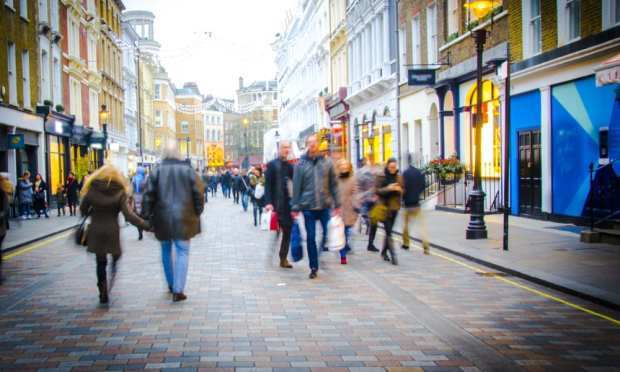How An eCommerce Startup Is Bringing UK’s High Street Home

If you can’t get shoppers to go to High Street, bring High Street to them. In fact, let them create their own High Street. That’s the general business model behind Streetify, a unique eCommerce concept that launched last week in the U.K.
Streetify provides virtual stores for every business’ website, replicating the shopping experience by street, based on location. Shoppers can find out which shops are open, pre-order items for pickup or arrange for delivery, all in a remote eCommerce model. It is available throughout the U.S., Canada, the U.K., India and Australia as a website and free app for both iOS and Android, and will be rolling out elsewhere this year.
“Since launching Streetify last week, we have now transformed over five million local stores and national websites into virtual stores, so firms and consumers can respond to the difficult circumstances we find ourselves in,” said Founder Martin Banbury. “We hope many businesses and jobs can be saved with this new technology.”
The plans for Streetify’s launch were in place before the COVID-19 crisis hit, and Banbury is currently working with the U.K. government to help businesses use it while the country is on lockdown. The site goes far beyond the U.K., however.
Here’s what the shopper sees, using 5th Avenue in New York City as a model. After going to the street on the site, the user scrolls left or right depending on the direction they want to travel. They actually see the same storefronts that exist on the real 5th Avenue, although in a graphic depiction.
Take, for example, Bluestone Lane Upper East Side Café at 1085 5th Avenue. When the user clicks on the virtual storefront, they visit a special store website that offers information about the shop, special offers and the store’s standard eCommerce inventory. The merchant has the opportunity to list the deal sites they cooperate with as well as unique promotions it wants to offer via Streetify.
Banbury noted that Streetify has the most voucher codes, cashback and coupons of any online platform, searching over 50 top sites, like Groupon, Rakuten and Honey, for deals. It puts checked deal site links in store windows, along with any messages from the store owners.
“We haven’t even scratched the surface of the possibilities here,” said Banbury. “On our virtual shopping boulevards, business owners can easily put messages in their storefront windows announcing deals, new hours, delivery options, what goods they have in stock and more – all for free for the year.”
While 5th Avenue and London’s Oxford Street are featured, consumers can create and organize multiple personalized avenues comprising their favorite stores. Choices can be shared via social media, and shoppers will be able to follow celebrities and buy from their favorite stores and sponsors. In fact, Banbury expects the marketing for Streetify to focus on influencers. Imagine following a fashion blogger right to the storefront of Fendi, or getting a code from a celebrity chef to shop on Streetify’s Williams-Sonoma locations, or even a special discount for visiting the physical shop. To enhance the feeling of realism, Streetify is geo-referenced so that at night, the lights come on, and if it’s raining in the real world, it will rain in the Streetify world, and so on.
Banbury’s background is in advertising. For 10 years, he ran The Mission, which was the largest U.K. advertising agency at the time. Since then, he has worked at several internet startups, with the last three years devoted to getting Streetify up and running.
“I was having dinner with a friend of mine a few years ago and we were talking about how so many stores are just unshoppable, and it got me to thinking,” he said. “I wondered what it would be like to shop High Street from home. Now, just a week and 40,000 users old, I can tell you that the technology is colossal. Seven different languages, 30 different databases and we’re just getting started.”
Banbury does not want Streetify to cannibalize sales on the streets it recreates. He believes it can generate interest in brick-and-mortar locations and create jobs on some of the streets consumers will visit.
In the U.K., the government has put a tremendous amount of research into the decline of the high-end shops and neighborhoods that separate High Street from Main Street. For example, one study was so concerned with the lack of foot traffic in dozens of U.K. towns and cities that it called for a complete reinvention of the concept.
Others have been more conservative, including this recent blog post from the city of Brighton. “We’re only spoon-fed the prevailing view that British commercial life without a High Street of familiar names may as well be a nuclear wasteland. In actual fact, there has always been more than one way for retailers to make sales,” the blog states. “We have to adapt to suit the digital evolution we’re experiencing, and that doesn’t seem to be slowing down. Just because we don’t see as much of a demand for physical stores doesn’t mean that businesses are all collapsing and folding in on themselves. Shopping habits always have and always will continue to evolve. Just like we now drive cars instead of a horse and cart, our habits are changing to suit our lifestyles and needs. Businesses need to recognize that change as a natural part of the consumer process and stay agile to keep their business afloat.”
Banbury hopes to provide some of that agility. His next move will be to announce major celebrity involvement in the project and raise his first round of funding to market Streetify throughout the world.